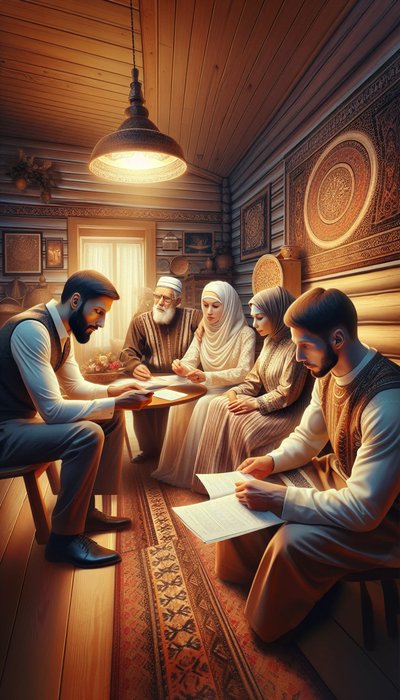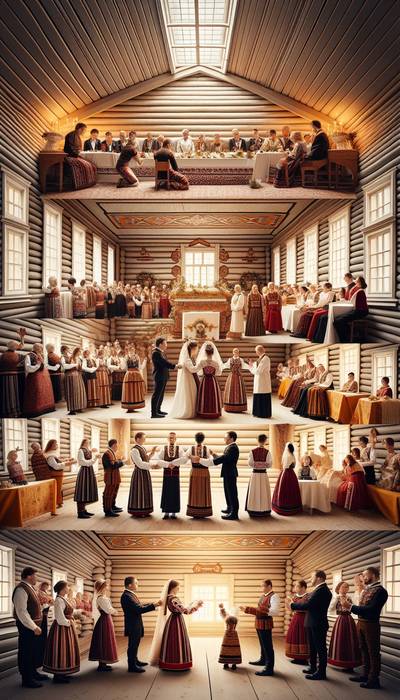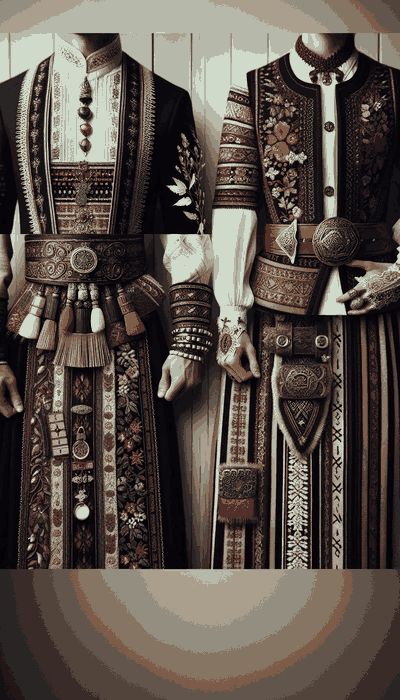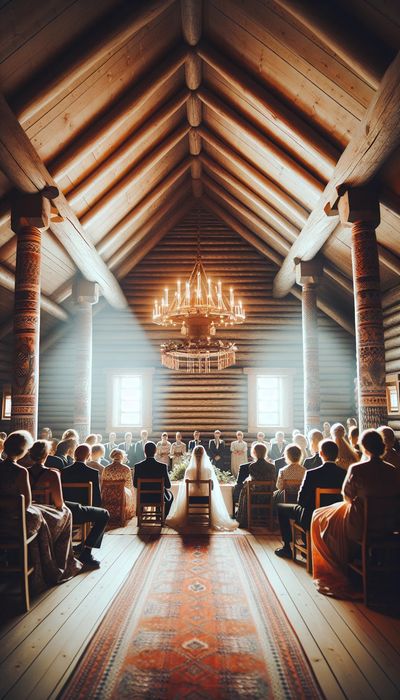Finnish Wedding Traditions
Finnish wedding traditions are a unique blend of centuries-old Nordic customs, Lutheran religious practices, and modern adaptations that create celebrations lasting 1-3 days with 50-200 guests. These traditions encompass pre-wedding rituals like the bridal sauna (morsiussaunaMOR-see-oos-SOW-nah), ceremonial bride kidnapping (morsiamenryöstöMOR-see-ah-men-REE-eus-teu), midnight soup service, and distinctive dual engagement rings, creating weddings that cost €15,000-30,000 ($16,500-33,000 USD) on average.

Complete Finnish Wedding Timeline

- 12-18 months before: Engagement with dual ring exchange
- 6-12 months before: Book venues, plan civil ceremony
- 3-6 months before: Send invitations, arrange pre-wedding celebrations
- 1 week before: PolttaritPOLT-tah-ritbachelor/bachelorette parties
- Night before: Bridal sauna ritual
- Wedding day: Civil ceremony, church wedding, reception with traditional games
- Post-wedding: Honeymoon, often at Finnish summer cottage (mökkiMER-kee)
What Are Finnish Engagement Traditions?

Finnish engagement customs feature both partners wearing gold engagement rings, a practice that symbolizes equality and occurs in 95% of Finnish engagements. This centuries-old tradition costs €500-2,000 ($550-2,200 USD) per ring and represents Finland’s progressive approach to partnership equality.
The Puhemies (Traditional Matchmaker)
PuhemiesPOO-heh-mee-es (poo-heh-mee-es) is the traditional Finnish matchmaker who historically negotiated marriages between families. This centuries-old practice involved:
- Formal family visits to discuss marriage terms
- Dowry negotiations ranging from household items to land
- Best man serving as primary negotiator
- Process lasting 2-6 months
Modern Practice: While professional matchmakers are rare, 70% of Finnish couples still hold formal family gatherings to celebrate engagements, maintaining cultural connections while embracing contemporary courtship.
Kapiot: The Finnish Wedding Dowry
KapiotKAH-pee-oht (kah-pee-oht) is the traditional Finnish bridal dowry consisting of handcrafted household items prepared by the bride to demonstrate readiness for married life. This tradition, dating back over 500 years, typically included:
- Textiles: 20-50 hand-woven items including rugs, blankets, tablecloths
- Embroidered goods: Pillowcases, towels with family patterns
- Kitchen items: Wooden utensils, pottery, preserved foods
- Total preparation time: 1-3 years before marriage
- Modern equivalent value: €5,000-15,000 ($5,500-16,500 USD)
Regional Variations:
- Coastal regions: Nautical-themed textiles, fish preservation tools
- Karelia (35% of eastern traditions): Russian-influenced elaborate embroidery
- Western Finland: Swedish-style geometric patterns, specific color schemes
Current Practice: Contemporary Finnish couples receive household gifts worth €2,000-5,000 ($2,200-5,500 USD) on average, with 40% of families passing down heirloom kapiot items.
Pre-Wedding Traditions and Ceremonies

Polttarit: Finnish Bachelor and Bachelorette Parties
PolttaritPOLT-tah-rit (polt-tah-rit) literally means “burning of single life” and represents the Finnish version of bachelor/bachelorette parties, typically held 1-2 weeks before the wedding. These celebrations involve:
- Duration: 1-3 days
- Participants: 5-20 close friends
- Average cost: €200-500 ($220-550 USD) per person
- Common activities: Sauna experiences, outdoor adventures, city celebrations
- Alcohol consumption: More moderate than American equivalents
Regional Polttarit Variations:
- Helsinki/Urban areas: Restaurant tours, spa treatments, nightclub celebrations
- Lapland: Reindeer sledding, northern lights viewing, ice hotel stays
- Coastal regions: Boat trips, island hopping, seafood feasts
- Eastern Finland: Traditional smoke saunas, forest activities
Family Pre-Wedding Gatherings
Finnish families typically organize 2-3 formal dinners before the wedding, strengthening bonds between families. These gatherings include:
- Participants: 10-30 immediate family members
- Cost: €500-1,500 ($550-1,650 USD) per event
- Traditional foods served: Salmon soup, Karelian pies, cloudberry desserts
- Duration: 3-5 hours
- Location: Usually at parents’ homes (65%) or restaurants (35%)
Finnish Wedding Ceremony Traditions

Morsiussauna: The Bridal Sauna Ritual
MorsiussaunaMOR-see-oos-SOW-nah (mor-see-oos-sow-nah) is the traditional Finnish bridal sauna, a purification ritual performed the night before the wedding that dates back over 1,000 years. This distinctive tradition involves:
- Participants: Bride plus 3-8 female friends/relatives
- Duration: 2-4 hours
- Temperature: 80-100°C (176-212°F)
- Special elements: Birch whisks (vihtaVIH-tah/vastaVAHS-tah), aromatic herbs
- Cost: €200-1,000 ($220-1,100 USD) for private sauna rental
Traditional Herbs Used:
- Birch leaves: For cleansing and good fortune
- Meadowsweet: For fertility and happiness
- Juniper: For protection from evil
- Rose petals: Modern addition for romance
Modern Adaptations: 60% of Finnish brides still participate in some form of bridal sauna, with 30% choosing spa packages that incorporate traditional elements alongside modern treatments costing €300-800 ($330-880 USD).
Civil Ceremony Requirements in Finland
Finnish civil ceremonies are legally required for all marriages and must be performed by authorized officials (maistraattiMAI-strah-tee) at least 1 week before any religious ceremony. This requirement includes:
- Duration: 15-30 minutes
- Cost: €150-500 ($165-550 USD)
- Witnesses required: 2 adults over 18 years
- Documentation needed: Birth certificates, proof of single status
- Languages available: Finnish, Swedish, English (in major cities)
- Booking timeline: 1-6 months in advance
Statistics: 100% of legally recognized Finnish marriages require civil ceremony, with 65% of couples also choosing religious ceremonies.
Church Wedding Traditions
Finnish church weddings follow primarily Lutheran traditions (75% of religious ceremonies) and feature specific customs:
- Duration: 45-90 minutes
- Guest capacity: 50-400 depending on church
- Cost: €500-2,000 ($550-2,200 USD) including organist and fees
- Music traditions: Finnish hymns, classical pieces, contemporary selections
- Processional order: Bride enters with father, exits with groom
Regional Religious Variations:
- Lutheran ceremonies (75% of religious weddings): Traditional hymns, formal liturgy
- Orthodox ceremonies (15% in eastern Finland): Icon veneration, crowning ritual
- Other denominations (10%): Pentecostal, Catholic, non-denominational
Traditional Finnish Wedding Attire
Finnish Bridal Fashion Evolution
Traditional Finnish bridal attire historically featured black dresses until the 1920s, with the distinctive bridal crown (morsiuskruunuMOR-see-oos-KROO-noo) being the key identifying element. Traditional elements include:
- Bridal crown (kruunuKROO-noo): Metal and bead construction, 500-1,000 grams
- Historical cost: Equivalent to 6 months’ wages
- Colors: Black (pre-1920), regional colors, white (modern)
- Embroidery patterns: Family-specific designs passed through generations
- Modern crown alternatives: Flower crowns (€100-300 / $110-330 USD)
Regional Bridal Attire Variations:
- Karelia region (eastern Finland): Geometric embroidery, red accents, Orthodox influences
- Western coastal areas: Swedish-influenced blues and yellows, maritime motifs
- Savo region (central Finland): Distinctive brooch patterns, specific weaving techniques
- Lapland: Sami influences, reindeer leather details, distinctive color patterns
Modern Practice: 80% of Finnish brides wear white gowns costing €1,000-5,000 ($1,100-5,500 USD), with 20% incorporating traditional elements like antique brooches or heirloom veils.
Groom’s Traditional and Modern Attire
Finnish groom’s attire has evolved from regional folk costumes to contemporary formal wear:
- Traditional elements: Dark wool suits, regional vests, family cufflinks
- Modern choices: Black tie (40%), dark suits (50%), morning dress (10%)
- Average cost: €500-2,000 ($550-2,200 USD)
- Winter wedding additions: Fur-trimmed accessories, heavier fabrics
- Rental vs purchase: 60% purchase, 40% rent
Finnish Wedding Party Roles
Kaaso and Best Man Responsibilities
KaasoKAH-so (kaa-so) is the Finnish equivalent of maid of honor, traditionally an older married woman who guides the bride. This role differs significantly from Western bridesmaids:
- Traditional requirements: Married status, age 25+, advisory role
- Modern kaaso: Usually bride’s sister or best friend
- Responsibilities: Organize polttaritPOLT-tah-rit, assist with preparations, hold rings
- Number in wedding party: Typically 1 kaaso, 1 best man (vs 4-8 in US)
- Attire cost: €200-500 ($220-550 USD)
Best Man (Bestman) duties include:
- Managing wedding logistics and timeline
- Organizing groom’s polttarit
- Giving primary wedding speech
- Leading traditional games
- Preventing excessive “bride kidnapping”
Finnish Wedding Reception Traditions
Morsiamenryöstö: The Playful Bride Kidnapping
MorsiamenryöstöMOR-see-ah-men-REE-eus-teu (mor-see-ah-men-ree-eus-teu) is the traditional Finnish bride kidnapping game performed at 70% of traditional wedding receptions. This theatrical tradition involves:
- Duration: 30-60 minutes
- Participants: 3-6 of groom’s friends as “kidnappers”
- Ransom activities: Singing, dancing, trivia about bride
- Common hiding spots: Nearby restaurant, friend’s house, hotel lobby
- Success rate: Groom “fails” first attempt 90% of time for entertainment
Regional Kidnapping Variations:
- Urban weddings: Quick restaurant visit, public performance
- Rural celebrations: Longer distances, outdoor challenges
- Coastal areas: Boat-based kidnappings
- Winter weddings: Sauna or ice bar locations
Traditional Finnish Wedding Games
Finnish wedding receptions feature interactive games engaging 80-100% of guests:
The Shoe Game (most popular):
- Couple sits back-to-back holding each other’s shoes
- Answer questions by raising appropriate shoe
- Duration: 10-15 minutes
- Guest participation: Shouting questions
Money Dance Variations:
- Traditional: Guests pay €5-20 ($5.50-22 USD) to dance with bride/groom
- Modern: Donation box, credit card reader available
- Average collected: €500-2,000 ($550-2,200 USD)
- Use of funds: Honeymoon or first home
Quiz Games:
- Questions about couple’s relationship
- Team competition between bride/groom’s sides
- Prizes: Finnish chocolates, small bottles of spirits
- Participation rate: 60-80% of guests
Finnish Wedding Dancing Traditions
Traditional Finnish wedding dances create structured celebration lasting 4-6 hours:
- Opening dance: Usually waltz, 3-4 minutes
- Polska dance: Traditional Finnish folk dance, 20% of weddings
- Humppa: Fast-paced Finnish dance, 50% of receptions
- Guest dances with couple: €10-50 ($11-55 USD) traditionally donated
- Final waltz: All guests participate, signals reception end
Modern additions: 70% include international music, 30% hire live bands costing €1,000-3,000 ($1,100-3,300 USD).
Finnish Wedding Food Traditions
Kransekake: The Nordic Wedding Cake
KransekakeKRAN-seh-kah-keh (kran-seh-kah-keh) is the traditional Scandinavian ring cake served at 40% of Finnish weddings:
- Structure: 18-36 almond paste rings forming cone
- Height: 50-100 cm (20-40 inches)
- Servings: 50-150 guests
- Cost: €200-600 ($220-660 USD)
- Decoration: White icing, Finnish flags, flowers
- Tradition: Couple lifts top rings together
Modern alternatives:
- Traditional Finnish cakes: 30% choose cloudberry or blueberry
- International styles: 50% opt for tiered fondant cakes
- Naked cakes: 20% select rustic styles
Midnight Soup Tradition
Finnish midnight soup (keskiyön keittoKES-kee-ern KAY-toh) serves as sustenance for guests celebrating past midnight:
- Service time: 12:00 AM - 2:00 AM
- Types: Meat soup (60%), fish soup (30%), vegetarian (10%)
- Traditional choice: Hearty beef and root vegetable soup
- Servings: 100-200 bowls typically prepared
- Cost: €5-10 ($5.50-11 USD) per serving
- Accompanied by: Rye bread, butter, cheese
This tradition occurs at 80% of weddings lasting past midnight, signaling the transition from formal reception to casual celebration.
Post-Wedding Finnish Traditions
Crown Gifting Ceremony
The crown gifting tradition (kruunun luovutusKROO-noon LOO-oh-voo-toos) occurs near reception end:
- Timing: Last hour of reception
- Participants: All unmarried women
- Process: Blindfolded bride selects recipient
- Belief: Recipient marries within one year (similar to bouquet toss)
- Modern crown value: €50-500 ($55-550 USD)
- Success rate: 30% of recipients marry within 18 months
Finnish Honeymoon Customs
Finnish honeymoon traditions blend modern travel with cultural elements:
Traditional mökkiMER-kee honeymoons (35% of couples):
- Location: Family summer cottage by lake
- Duration: 3-7 days
- Activities: Sauna, swimming, nature walks
- Cost: €500-1,500 ($550-1,650 USD)
- Privacy level: Complete isolation from others
International honeymoons (65% of couples):
Regional Finnish Wedding Variations
Eastern Finnish (Karelian) Wedding Traditions
Karelian wedding customs represent 20% of eastern Finnish weddings and feature distinctive Orthodox influences:
- Two-part ceremony: Blessing at bride’s home, celebration at groom’s
- Traditional laments (itkuvirsiIT-koo-VEER-see): Sung farewells lasting 20-30 minutes
- Guest count: 100-300 people (larger than western Finnish weddings)
- Food specialties: Karelian pies, Orthodox fasting considerations
- Duration: Often 2-3 days total
- Cost differential: 20-30% higher than western Finnish weddings
Distinctive Karelian elements:
- Red and gold color schemes
- Icon corners in reception venues
- Traditional kantele music
- Bread and salt blessing ceremony
Western Finnish Wedding Traditions
Western Finnish weddings show stronger Swedish and Nordic influences:
- Church processions: Public walks through town center
- Community involvement: 150-400 guests typical
- Maritime elements: 40% include boat transportation
- Swedish-speaking regions: 30% conduct ceremonies in Swedish
- Decoration style: Light woods, blue and yellow accents
- Music preferences: More classical, less folk music
Cost comparison: Western Finnish weddings average €20,000-35,000 ($22,000-38,500 USD), 15% higher than eastern regions.
Modern Finnish Wedding Trends 2025
Seasonal Wedding Preferences
Finnish wedding seasonality has shifted dramatically from historical patterns:
Summer weddings (June-August): 65% of all weddings
- Advantages: 18-20 hours daylight, warm weather
- Popular dates: Midsummer weekend, July Saturdays
- Venue availability: Book 12-18 months ahead
- Cost premium: 20-30% higher than off-season
Winter weddings (December-February): 15% of weddings
- Growing trend: 50% increase since 2020
- Attractions: Northern lights, snow landscapes, cozy atmosphere
- Average temperature: -5 to -25°C (23 to -13°F)
- Special considerations: Indoor venues, fur wraps, heated transport
Sustainability in Finnish Weddings
Eco-conscious Finnish weddings represent 40% of 2025 celebrations:
- Local sourcing: 80% use Finnish vendors exclusively
- Digital invitations: 60% choose paperless options
- Seasonal menus: 90% feature local, seasonal ingredients
- Carbon offsetting: 25% calculate and offset wedding emissions
- Second-hand elements: 45% incorporate vintage or borrowed items
- Average cost savings: 15-25% compared to traditional weddings
Technology Integration
Digital elements in modern Finnish weddings:
- Wedding websites: 85% of couples create custom sites
- Livestreaming: 50% offer virtual attendance options
- Digital guestbooks: 40% use QR codes for messages
- Social media: Custom hashtags used by 70%
- Photo sharing: Cloud albums for 60% of weddings
- Average tech budget: €500-1,500 ($550-1,650 USD)
Finnish Wedding Cost Breakdown 2025
Comprehensive Budget Analysis
Average Finnish wedding costs €15,000-30,000 ($16,500-33,000 USD) for 100 guests:
Major expenses:
- Venue rental: €2,000-5,000 ($2,200-5,500 USD) - 20% of budget
- Catering: €5,000-10,000 ($5,500-11,000 USD) - 35% of budget
- Photography/video: €2,000-4,000 ($2,200-4,400 USD) - 12% of budget
- Attire: €1,500-3,000 ($1,650-3,300 USD) - 10% of budget
- Music/entertainment: €1,000-3,000 ($1,100-3,300 USD) - 8% of budget
- Flowers/decorations: €1,000-2,500 ($1,100-2,750 USD) - 7% of budget
- Other expenses: €2,500-5,500 ($2,750-6,050 USD) - 8% of budget
Regional cost variations:
- Helsinki area: 25-40% above national average
- Rural areas: 15-30% below average
- Lapland: 20% premium for destination weddings
- Archipelago: 30% premium for island venues
Popular Finnish Wedding Venues
Traditional Venue Categories
Finnish wedding venues offer diverse options reflecting the country’s natural beauty:
Churches and chapels (35% of ceremonies):
- Capacity: 50-500 guests
- Cost: €500-2,000 ($550-2,200 USD)
- Popular choices: Temppeliaukio Church (Helsinki), Turku Cathedral
- Booking timeline: 6-12 months advance
Manor houses (25% of receptions):
- Historical significance: 100-300 year old buildings
- Guest capacity: 80-250 people
- Cost: €3,000-8,000 ($3,300-8,800 USD)
- Included services: Often provide catering, decorations
Lakeside venues (20% of weddings):
- Unique feature: 188,000 lakes to choose from
- Season: Primarily June-August
- Cost: €2,000-6,000 ($2,200-6,600 USD)
- Popular regions: Lake Saimaa, Finnish Lakeland
Modern urban venues (20% of weddings):
- Style: Industrial, minimalist, contemporary
- Capacity: 50-300 guests
- Cost: €2,500-7,000 ($2,750-7,700 USD)
- Technology: Built-in AV systems, lighting
1. How much does an average Finnish wedding cost in 2025?
Finnish weddings typically cost €15,000-30,000 ($16,500-33,000 USD) for 100 guests. This includes venue rental (€2,000-5,000), catering (€5,000-10,000), photography (€2,000-4,000), and other essential expenses. Helsinki weddings cost 25-40% more than the national average, while rural celebrations can be 15-30% less expensive. Couples usually save for 12-18 months and may receive family contributions covering 20-40% of costs.
2. What is the bridal sauna (morsiussauna) tradition?
MorsiussaunaMOR-see-oos-SOW-nah is a traditional Finnish purification ritual performed the night before the wedding, dating back over 1,000 years. The bride and 3-8 female friends/relatives spend 2-4 hours in a sauna heated to 80-100°C (176-212°F), using birch whisks and aromatic herbs like meadowsweet and juniper. About 60% of Finnish brides still participate in some form of bridal sauna, with modern spa adaptations costing €300-800 ($330-880 USD).
3. Do both partners wear engagement rings in Finland?
Yes, both partners wearing engagement rings is standard practice in 95% of Finnish engagements. This tradition symbolizes equality in the relationship and typically involves gold rings costing €500-2,000 ($550-2,200 USD) each. The mutual exchange reflects Finland’s progressive approach to partnership and differs from many Western traditions where only the woman wears an engagement ring.
4. What is morsiamenryöstö (bride kidnapping)?
MorsiamenryöstöMOR-see-ah-men-REE-eus-teu is a playful Finnish wedding reception game where the groom’s friends “kidnap” the bride while he’s distracted. To get her back, the groom must complete challenges like singing, dancing, or answering trivia questions about his bride. This 30-60 minute tradition occurs at 70% of traditional Finnish weddings and adds entertainment value to the reception. The groom typically “fails” the first attempt for comedic effect.
5. When is the best time of year for a Finnish wedding?
Summer months (June-August) host 65% of Finnish weddings due to 18-20 hours of daylight and warm weather. However, winter weddings (December-February) are growing in popularity, increasing 50% since 2020, offering northern lights, snow landscapes, and cozy atmospheres. Summer venues book 12-18 months in advance and cost 20-30% more than off-season options.
6. What is midnight soup and why is it served?
Finnish midnight soup (keskiyön keittoKES-kee-ern KAY-toh) is hearty soup served between 12:00 AM - 2:00 AM at weddings lasting past midnight. This tradition provides sustenance for late-night celebrators and signals the transition from formal reception to casual party. Served at 80% of all-night weddings, options include meat soup (60%), fish soup (30%), or vegetarian (10%), costing €5-10 ($5.50-11 USD) per serving with rye bread accompaniment.
7. Is a civil ceremony required in Finland?
Yes, civil ceremonies are legally required for all Finnish marriages and must occur at least 1 week before any religious ceremony. Performed by authorized officials (maistraattiMAI-strah-tee), these 15-30 minute ceremonies cost €150-500 ($165-550 USD) and require 2 adult witnesses. While 100% of legal marriages need civil ceremonies, only 65% of couples also choose religious ceremonies.
8. What are typical Finnish wedding favors?
Finnish wedding favors typically include locally-made items reflecting the country’s craftsmanship traditions. Popular choices include handcrafted wooden items (€5-15 per guest), Finnish chocolates like Fazer (€3-8), or small bottles of Finnish spirits like Koskenkorva or Salmiakki liqueur (€8-15). About 70% of weddings provide favors, with couples spending €300-800 ($330-880 USD) total on 100 guests.
9. How do Finnish wedding party roles differ from American weddings?
Finnish weddings typically feature just one kaasoKAH-somaid of honor and one best man rather than large wedding parties of 4-8 people common in American weddings. The kaaso traditionally was an older married woman who advised the bride, though today it’s usually the bride’s sister or best friend. These smaller wedding parties reflect Finnish preferences for intimate, meaningful relationships over elaborate ceremonies.
10. Are destination weddings within Finland popular?
Yes, domestic destination weddings are increasingly popular, with 30% of Finnish couples marrying outside their hometowns. Popular destinations include Lapland for winter weddings (featuring reindeer sleigh rides and northern lights), lakeside venues in Finnish Lakeland, historic manor houses, and archipelago islands. These Finnish destination weddings cost 20-30% more than hometown celebrations but offer unique natural settings while keeping guests within the country.
Frequently Asked Questions
1. How much does an average Finnish wedding cost in 2025?
The short answer: €15,000-30,000 ($16,500-33,000 USD) for 100 guests, but this varies wildly based on location and ambition. Helsinki weddings run 25-40% above the national average - that trendy Punavuori venue and craft cocktails add up quickly. Rural celebrations can cost 30% less, especially if you have connections to community halls or family properties.
Most couples save for 12-18 months, and here's a Finnish reality: parents often contribute 20-40% of costs, though this is decreasing as couples marry later (average age: 32 for women, 34 for men). The biggest cost-saver? Finnish weddings typically happen on Saturdays only, but Friday weddings can slash venue costs by 20%.
How much does a typical Finnish wedding cost?
A typical Finnish wedding costs between €15,000-30,000 for 100 guests, including venue, catering, photography, and attire.
2. What is the bridal sauna (morsiussauna) tradition?
Think of morsiussauna as meditation meets purification meets bachelorette party - but with more nudity and birch branches. This thousand-year-old tradition sees the bride and her closest female friends/relatives spend the night before the wedding in a proper Finnish sauna, heated to 80-100°C (176-212°F).
It's not just about sweating out pre-wedding jitters. Women share marriage advice, use special herbs like meadowsweet for fertility, and create a sacred space for the bride's transition. About 60% of Finnish brides still participate, though modern versions might happen at spa hotels rather than smoke saunas. Pro tip: if you're invited to a morsiussauna, it's a serious honor. Don't decline unless you have genuine sauna health restrictions.
What is morsiussauna and why is it important?
Morsiussauna is a traditional pre-wedding sauna ritual lasting 2-4 hours at 80-100°C, symbolizing purification and preparation for marriage.
3. Do both partners wear engagement rings in Finland?
Absolutely! This is one of those Finnish traditions that makes foreigners do a double-take. In 95% of Finnish engagements, both partners sport matching gold bands on their right ring fingers. When the wedding arrives, these same rings often move to the left hand - practical and symbolic.
The tradition speaks to Finnish values around equality. Why should only one partner display their committed status? Rings typically cost €500-2,000 ($550-2,200 USD) each, and yes, couples usually shop together. There's no surprise proposal with a mystery ring - Finnish pragmatism strikes again.
Do Finnish couples have both civil and church weddings?
Yes, civil ceremonies are legally required, and 65% of couples also have church weddings, costing €500-2,000.
4. What is morsiamenryöstö (bride kidnapping)?
Picture the groom deep in conversation with relatives when suddenly - chaos. His friends have "kidnapped" the bride! This playful tradition, happening at 70% of traditional Finnish weddings, creates scheduled spontaneity (yes, that's a Finnish thing).
The kidnappers might take her to a nearby bar where the groom must perform increasingly ridiculous tasks: singing love songs, answering relationship trivia, or dancing traditional folk dances. The first rescue attempt always "fails" - entertainment value matters more than efficiency. The whole production lasts 30-60 minutes and gives everyone great photo opportunities. Winter kidnappings might involve saunas, summer ones could include boat chases. It's theatrical, slightly silly, and absolutely beloved.
What is morsiamenryöstö?
Morsiamenryöstö is a traditional 'bride kidnapping' game performed at 70% of Finnish wedding receptions, adding fun and entertainment.
5. When is the best time of year for a Finnish wedding?
Summer dominates with 65% of weddings between June and August, and for good reason: 18-20 hours of daylight create endless photo opportunities, guests can enjoy outdoor venues, and the weather actually cooperates (mostly). But here's the trend: winter weddings have increased 50% since 2020.
Why winter? Northern lights make spectacular backdrops, snow transforms ordinary venues into wonderlands, and off-season pricing can save 20-30%. Plus, international guests get a true Finnish experience. The trade-offs: limited daylight (as little as 6 hours in December), temperature challenges for outdoor moments, and weather-dependent travel. Book summer venues 12-18 months ahead; winter gives more flexibility.
What is kapiot in Finnish weddings?
Kapiot is the traditional Finnish bridal dowry consisting of handcrafted household items, valued at €2,000-5,000 in modern times.
6. What is midnight soup and why is it served?
Around 12:30 AM at Finnish weddings, just when formal festivities fade and only the dedicated dancers remain, kitchen staff emerge with steaming bowls of soup. This is keskiyön keitto - midnight soup - and it's genius-level event planning.
The tradition acknowledges that Finns celebrate earnestly. If your wedding lasts past midnight (80% do), guests need substantial fuel. The soup - usually hearty meat-and-vegetable, salmon, or increasingly, vegetarian options - costs about €5-10 ($5.50-11 USD) per serving. It's served with rye bread, butter, and sometimes cheese. More than mere sustenance, midnight soup marks the reception's personality shift from formal to familiar. Ties loosen, real conversations start, and the party's second wind kicks in.
When do most Finnish weddings take place?
65% of Finnish weddings occur in summer, while winter weddings are growing in popularity, now accounting for 15%.
7. Is a civil ceremony required in Finland?
Yes, and this catches many international couples off-guard. Finnish law requires a civil ceremony at the maistraatti (registry office) before any religious celebration. This isn't a quick paper-signing - it's a legitimate ceremony with vows, rings, and legal weight.
The logistics: book 1-6 months ahead (summer Saturdays fill fast), bring two witnesses over 18, pay €150-500 ($165-550 USD) depending on location. The ceremony takes 15-30 minutes and must happen at least one week before any church wedding. While 100% of legal marriages need civil ceremonies, only 65% add religious ceremonies. Some couples embrace this two-ceremony tradition, hosting intimate civil ceremonies on Thursday, then larger celebrations on Saturday.
What is the traditional Finnish wedding cake?
Kransekake, a tall ring cake of Nordic origin, is served at 40% of Finnish weddings.
8. What are typical Finnish wedding favors?
Finnish wedding favors reflect the culture's preference for practical over precious. Forget personalized shot glasses gathering dust - Finnish couples choose items guests will actually use or consume.
Popular choices include locally-made items: hand-carved wooden spoons (€5-15 / $5.50-16.50 USD each), Finnish chocolates like Fazer (€3-8 / $3.30-8.80 USD), or small bottles of salmiakki liqueur for the brave (€8-15 / $8.80-16.50 USD). About 70% of weddings provide favors, budgeting €300-800 ($330-880 USD) total. The trend toward sustainability means more couples skip physical favors entirely, instead making charitable donations or planting trees in guests' names.
How long do Finnish wedding celebrations last?
Finnish weddings typically last 1-3 days, including pre-wedding celebrations and the main ceremony day.
9. How do Finnish wedding party roles differ from American weddings?
Here's where Finnish minimalism shines: forget matching bridesmaid dresses in questionable colors. Finnish weddings typically feature just one kaaso (maid of honor) and one best man. That's it. No color-coordinated brigade, no groomsmen hierarchy, no drama about who stands where.
The kaaso traditionally needed to be married and over 25 - someone with wisdom to guide the bride. Today she's usually the bride's sister or best friend, regardless of marital status. These smaller wedding parties mean real responsibility: the kaaso and best man run the show, from organizing pre-wedding events to managing reception games. It reflects Finnish values perfectly - quality relationships over quantity, substance over show.
What role does the kaaso play in Finnish weddings?
The kaaso (maid of honor) assists the bride throughout wedding planning and ceremonies, similar to Western traditions.
10. Are destination weddings within Finland popular?
Absolutely! About 30% of Finnish couples marry outside their hometowns, but here's the Finnish twist - they stay within national borders. Lapland leads winter destination weddings with reindeer, northern lights, and ice hotels. Summer couples choose lakeside venues in Finnish Lakeland or archipelago islands requiring boat transport.
These domestic destinations offer unique experiences while keeping logistics manageable for Finnish guests. Costs run 20-30% higher than hometown weddings, mainly due to accommodation and transport. Popular packages include: Lapland winter wonderlands (December-March), midnight sun celebrations (June-July), archipelago island escapes (May-September), and historic manor houses year-round. The key advantage? Guests experience Finland's diverse landscapes while celebrating your union.
Are Finnish weddings becoming more sustainable?
Yes, 40% of 2025 Finnish weddings are expected to be eco-conscious, featuring local sourcing and second-hand items.